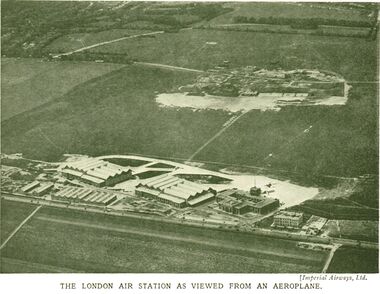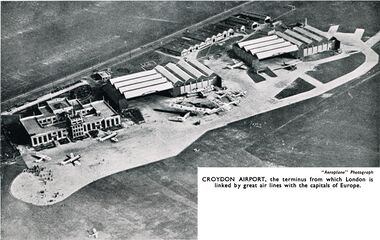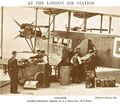Category:Croydon Airport: Difference between revisions
(+image) |
No edit summary |
||
| Line 3: | Line 3: | ||
{{Box|Croydon_Airport_(PowerSpeed_1938).jpg|'''1938:''' Croydon Airport|380}} | {{Box|Croydon_Airport_(PowerSpeed_1938).jpg|'''1938:''' Croydon Airport|380}} | ||
'''Croydon Airport, London Air Station'''. | '''Croydon Airport, London Air Station'''. | ||
==Visual recognition== | |||
Croydon's most distinctive feature was its square aircraft Control Tower, with railings and a central aerial: photographers taking a photo of an aircraft at Croydon would often try to get the Control Tower "in shot", and artists would often try to squeeze it into the corner of an aeroplane painting, due to the Tower's recognition factor. | |||
==Commercial flight== | |||
Between the Wars, Croydon Airport (styled "'''London Air Station'''", to match London's main railway terminus stations) was London's main commercial airport, and the main base for '''[[Imperial Airways]]'''. The central Hall of the airport building looked very like the interior of a railway station, with wooden benches, arrival-departure indicators, and a main clock. Since Croydon was so strongly set up for commercial air traffic, private flyers tended to use the more enthusiast-friendly services at [[Heston]]. | |||
{{Quotation2|<h4>London's Air Port, 1934</h4> | |||
Such is the development of aircraft in recent years that only three years separate the statement, made to the Wright Brothers in 1912 by a Cabinet Minister, that "His Majesty's Navies had no use for aeroplanes" from the first utilisation of Croydon as a centrepoint for aerial traffic. In 1919 H.R.H. the Duke of York obtained his "wings" at Croydon, and the port, with the Air Ministry for Port Authority, is now the headquarters of comercial aviation in England and the starting-point for air routes leading all over the world. Besides the custom-houses the buildings include a C.I.D. Hall and a meteorological department. | |||
|Author=Churchman's Cigarettes|Publication="The Story of London", card 50|Date=1934}} | |||
<gallery mode="packed-hover" heights=180px align=left> | <gallery mode="packed-hover" heights=180px align=left> | ||
| Line 19: | Line 29: | ||
{{Airport}} | {{Airport}} | ||
{{Imperial}} | |||
Revision as of 15:46, 11 May 2023
Croydon Airport coordinates: 51.356389, -0.117222
1928: "London Air Station", Croydon [image info]
1938: Croydon Airport [image info]
Croydon Airport, London Air Station.
Visual recognition
Croydon's most distinctive feature was its square aircraft Control Tower, with railings and a central aerial: photographers taking a photo of an aircraft at Croydon would often try to get the Control Tower "in shot", and artists would often try to squeeze it into the corner of an aeroplane painting, due to the Tower's recognition factor.
Commercial flight
Between the Wars, Croydon Airport (styled "London Air Station", to match London's main railway terminus stations) was London's main commercial airport, and the main base for Imperial Airways. The central Hall of the airport building looked very like the interior of a railway station, with wooden benches, arrival-departure indicators, and a main clock. Since Croydon was so strongly set up for commercial air traffic, private flyers tended to use the more enthusiast-friendly services at Heston.
London's Air Port, 1934
Such is the development of aircraft in recent years that only three years separate the statement, made to the Wright Brothers in 1912 by a Cabinet Minister, that "His Majesty's Navies had no use for aeroplanes" from the first utilisation of Croydon as a centrepoint for aerial traffic. In 1919 H.R.H. the Duke of York obtained his "wings" at Croydon, and the port, with the Air Ministry for Port Authority, is now the headquarters of comercial aviation in England and the starting-point for air routes leading all over the world. Besides the custom-houses the buildings include a C.I.D. Hall and a meteorological department.
— , Churchman's Cigarettes, , "The Story of London", card 50, , 1934
Passengers:
Media in category ‘Croydon Airport’
The following 17 files are in this category, out of 17 total.
- Armstrong Whitworth Argosy G-EBLF, leaving Croydon (WBoA 6ed 1928).jpg 3,000 × 2,202; 1.11 MB
- Atalanta G-ABPI, over Croydon (WBoA 8ed 1934).jpg 1,879 × 3,000; 1,005 KB
- Croydon Airport (PowerSpeed 1938).jpg 3,000 × 1,894; 1.35 MB
- Entrance Hall, London Air Station, Croydon (WBoA 6ed 1928).jpg 3,000 × 2,494; 1.55 MB
- Floodlight at London Air Station, Croydon (WBoA 6ed 1928).jpg 3,000 × 1,616; 721 KB
- Fokker F-XX SilverMeeuw PH-AIZ, at Croydon (WBoA 8ed 1934).jpg 3,000 × 2,561; 1,012 KB
- Golden Clipper airliner at Croydon, Wibault 282 (WBoA 8ed 1934).jpg 2,008 × 3,000; 1.35 MB
- Hanno, HP-42 Heracles-Class G-AAUD (WBoA 8ed 1934).jpg 3,000 × 2,212; 927 KB
- Lady Bailey, DH Moth, Croydon (WBoA 6ed 1928).jpg 3,000 × 2,020; 1.02 MB
- London Air Station, Croydon, aerial view (WBoA 6ed 1928).jpg 3,000 × 2,321; 1.44 MB
- London Station Air Tower, Croydon (WBoA 6ed 1928).jpg 3,000 × 2,356; 1.26 MB
- Lufthansa Junkers, arriving at Croydon (MM 1931-08).jpg 3,000 × 1,552; 660 KB
- MM-Section Air News 2.jpg 2,182 × 711; 535 KB
- Passenger Luggage, Croydon (WBoA 6ed 1928).jpg 3,000 × 2,593; 1.55 MB
- Passengers boarding an Armstrong Whitworth Argosy G-EBOZ at Croydon (WBoA 6ed 1928).jpg 3,000 × 1,950; 955 KB
- Railway Air Services biplane, City of Birmingham (BRIPAW 1944).jpg 1,600 × 1,124; 556 KB
- Railway Air Services Ltd, City of Birmingham, GWR (GWP 1935).jpg 2,500 × 1,445; 778 KB



































